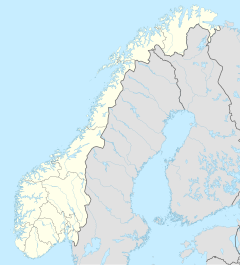Øvre Anárjohka National Park
| Øvre Anárjohka National Park | ||
|---|---|---|
|
|
||
| Location: | Norway | |
| Next city: | Karasjok | |
| Surface: | 1409 km² | |
| Founding: | 1975 | |
| The national parks in Northern Norway (Øvre-Anárjohka has number 25) | ||
The Øvre-Anárjohka National Park ( Norwegian Øvre Anárjohka nasjonalpark ) is a Norwegian national park on the border with Finland . The 1,409 sq km national park was established in 1975 to the largely untouched landscape, which as representative of the whole Finnmark - plateau can be considered, with its pine trees - and birch - Krattwäldern , marshes , waters , rivers , low mountains and the characteristic flora and to preserve and protect flora.
The park belongs to the municipalities of Karasjok and Kautokeino in the province of Troms og Finnmark . In the south and west it borders on the Finnish Lemmenjoki National Park .
Geography, landscape and geology
The national park is located on the upper reaches of the Anárjohka , in the southeast of the Finnmarksvidda plateau. In addition to the forests and different bodies of water, the landscape is also characterized by moors . The moors and swamps, some of which are several square kilometers in size, are often a problem when crossing the national park.
In total there are over 700 lakes in Øvre-Anárjohka, of which Gavdnjajávri is the largest. In addition, many rivers have their source there.
Flora and fauna
The flora is strongly influenced by Siberian species such as long-leaved speedwell , Siberian lettuce , simple meadow rue , small meadow rue , blue sky ladder , Lapland buttercup , northern milkweed and narrow-leaved cotton grass .
There is a great diversity of birds throughout the park, with most of them in the eastern part. The largest mammal in the park is the elk , which can only be found there in summer. The brown bear and the wolverine spend the winter there. In addition, foxes , weasels and various rodents live in the national park. One of the few occurrences of the polar oyster in Norway is also in Øvre Anárjohka.
heritage Site
The area of the national park has been used for centuries as a grazing area for Sami reindeer herds .
Gold has also been mined non-commercially in the park since the 1960s.
Tourism and administration
The national park is only partially suitable for hiking as there are hardly any paths. You need a permit to fish. The responsible information center is Øvre Pasvik nasjonalparksenter .
See also
Web links
literature
- Leif Ryvarden : Stabbursdalen, Øvre Pasvik and Øvre Anárjohka (= Norges nasjonalparker. Vol. 3). Gyldendal, Oslo 2007, ISBN 978-82-05-37638-0 .
- Sigmund Sivertsen: Øvre Anarjokka. In: Den norske turistforenings årbok . 1969, ISSN 0801-5481 .

